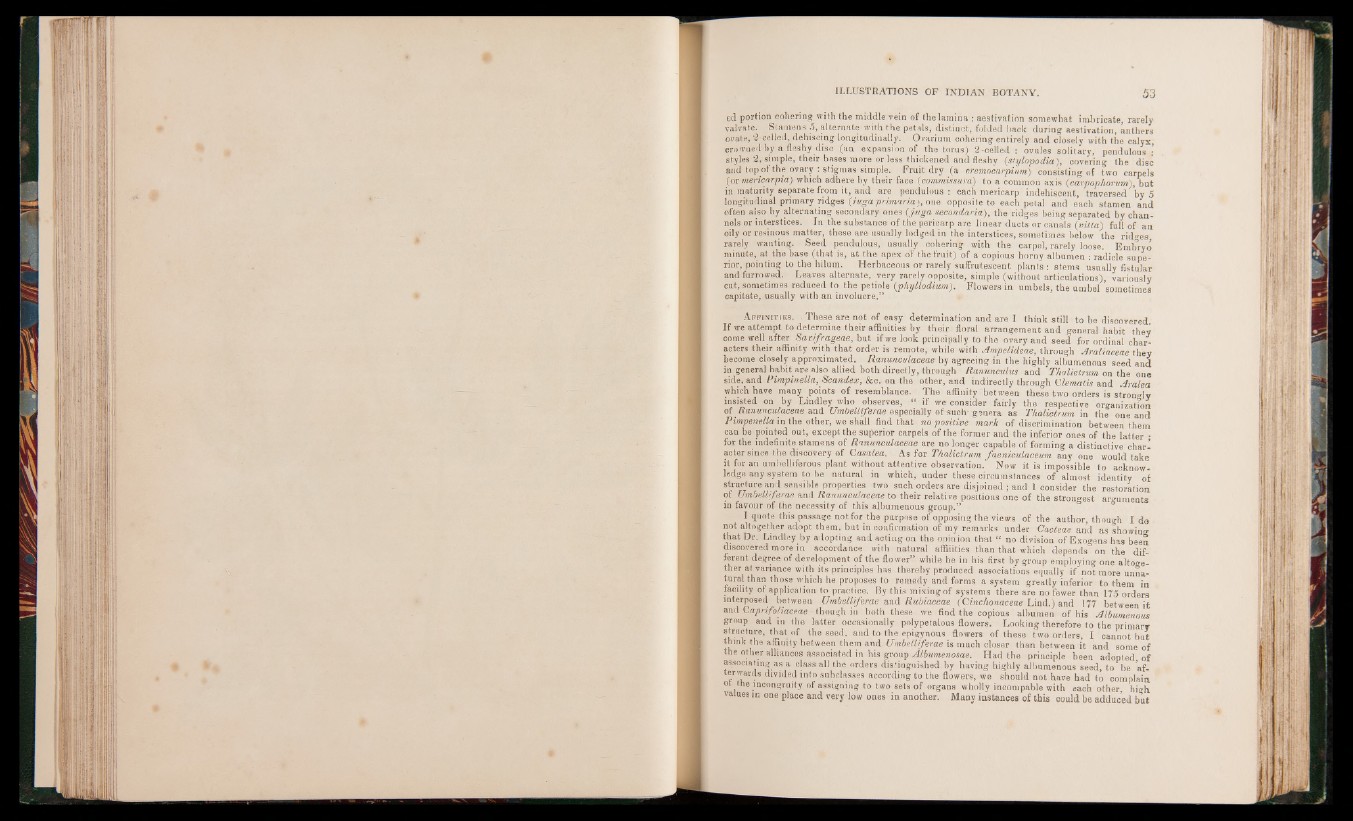
cd portion cohering with the middle vein of the lamina : aestivation somewhat imbricate, rarely
valvate. Stamens 5, alternate with the petals, distinct, folded back during aestivation, anthers
ovate, '2 celled, dehiscing longitudinally. Ovarium cohering entirely and closely with the calyx,
crowned by a fleshy disc (an expansion of the torus) 2 -celled : ovules solitary, pendulous-
styles 2, simple, their bases more or less thickened and fleshy (s/ylopodia), covering the disc
and top of the ovary : stigmas simple. Fruit dry (a eremocarpium) consisting of two carpels
(or mericarpia) which adhere by their face (commissure) to a common axis (carpophorvm), but
in maturity separate from it, and are pendulous : each mericarp indehiscent, traversed by 5
longitudinal primary ridges (iuga primaria.}, one opposite to each petal and each stamen and
often also by alternating secondary ones (juga secondaria), the ridges being separated by channels
or interstices. In the substance of the pericarp are linear ducts or canals (vitta) full of an
oily or resinous matter, these are usually lodged in the interstices, sometimes below the ridges
rarely wanting. Seed pendulous, usually cohering with the carpel, rarely loose. Embryo
minute, at the base (that is, at the apex of the fruit) of a copious horny albumen : radicle superior,
pointing to the hilum. Herbaceous or rarely suffrutescent plants : stems usually fistular
and furrowed. Leaves alternate, very rarely opposite, simple (without articulations), variously
cut, sometimes reduced to the petiole (phyllodium). Flowers in umbels, the umbel sometimes
capitate, usually with an involucre.”
A ffinities. These are not of easy determination and are I think still to be discovered.
If we attempt to determine their affinities by their floral arrangement and general habit they
come well after Sacifrageae, but if we look principally to the ovary and seed for ordinal characters
their affinity with that order is remote, while with Ampelideae, through Araliaeeae they
become closely approximated. Ranunculaceae by agreeing in the highly albumenous seed and
in general habit are also allied both directly, through Ranunculus and Thalietrum on the one
side, and Pimpinella, Scandex, See. on the other, and indirectly through Clematis and Aralea
which have many points of resemblance. The affinity between these two orders is strongly
insisted on by Lindley who observes, “ if we consider fairly the respective organization
of Ranunculaceae and Umbelliferae especially of such- genera as Thalietrum in the one and
Pimpenella in the other, we shall find that no positive mark of discrimination between them
can be pointed out, except the superior carpels of the former and the inferior ones of the latter •
for the indefinite stamens of Ranunculaceae are no longer capable of forming a distinctive character
since the discovery of Casalea. As for Thalietrum faeniculaceum any one would take"
it for an umbelliferous plant without attentive observation. Now it is impossible to acknowledge
any system to be natural in which, under these circumstances of almost identity of
structure and sensible properties two such orders are disjoined ; and 1 consider the restoration
of Umbelliferae and Ranunculaceae to their relative positions one of the strongest arguments
in favour of the necessity of this albumenous group.”
I quote this passage not for the purpose of opposing the views of the author, though Id o
not altogether adopt them, but in confirmation of my remarks under Cacteae and as showing
that Dr. Lindley by adopting and acting on the opinion that “ no division of Exogens has been
discovered more in accordance with natural affiiities than that which depends on the different
degree of development of the flower” while he in his first by group employing one altogel
‘her at variance with its principles has Thereby produced associations equally if not more unnatural
than those which he proposes to remedy and forms a system greatly inferior to them in
facility of application to practice. By this mixing of systems there are no fewer than 175 orders
interposed between Umbelliferae and Rubiaceae (Cinchonaceae Lind.) and 177 between it
and Caprifoliaceae -Though in both these we find the copious albumen of his Albumenous
group and in the latter occasionally polypetalous flowers. Looking therefore to the primary
structure, that of the seed, and to the epigynous flowers of these two orders, I cannot but
think the affinity between them and Umbelliferae is much closer than between it and some of
the other alliances associated in his group Albumenosae. Had the principle been adopted of
associating as a class all the orders distinguished by having highly albumenous seed, to be afterwards
divided into subclasses according to the flowers, we should not have bad to complain
ot the incongruity of assigning to two sets of organs wholly incompable with each other, high
values in one place and very low ones in another. Many instances of this could be adduced but